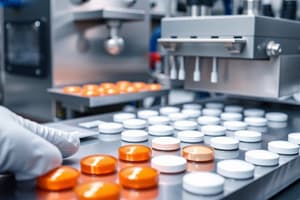Podcast
Questions and Answers
What is the main purpose of lubricants in tablet formulation?
What is the main purpose of lubricants in tablet formulation?
- To prevent tablets from sticking together (correct)
- To improve the flowability of the powder during tablet compression
- To increase the mechanical strength of the tablet
- To prevent the tablet from dissolving too quickly in the stomach
Which of the following compounds can act as both a glidant and a lubricant?
Which of the following compounds can act as both a glidant and a lubricant?
- Stearic acid
- Talc (correct)
- Starch (correct)
- Magnesium stearate
What is the primary function of tablet coatings?
What is the primary function of tablet coatings?
- To protect the tablet from the environment (correct)
- To enhance the stability of the active ingredient
- To improve the taste of the tablet
- To increase the dissolution rate of the tablet
Which of the following is NOT a benefit of tablet coatings?
Which of the following is NOT a benefit of tablet coatings?
What type of coating is used to delay the release of the active ingredient in the stomach?
What type of coating is used to delay the release of the active ingredient in the stomach?
Which of the following materials is commonly used in film coating?
Which of the following materials is commonly used in film coating?
What is the main purpose of coloring agents in tablet formulation?
What is the main purpose of coloring agents in tablet formulation?
What is the primary source of coloring agents in tablet formulation?
What is the primary source of coloring agents in tablet formulation?
Which of the following is NOT a potential benefit of coloring agents in tablet formulation?
Which of the following is NOT a potential benefit of coloring agents in tablet formulation?
What is the name of the authorization given by the European Medicines Agency for a drug?
What is the name of the authorization given by the European Medicines Agency for a drug?
What is the oldest source of drugs?
What is the oldest source of drugs?
What is a common use for cod liver?
What is a common use for cod liver?
Which of these is NOT a part of a plant that can be used as a source of drugs?
Which of these is NOT a part of a plant that can be used as a source of drugs?
What is the name of the agency in Australia that provides a Provisional Pathway for drug approval?
What is the name of the agency in Australia that provides a Provisional Pathway for drug approval?
What is the name of the authorization given by the China National Medicinal Products Administration for a drug?
What is the name of the authorization given by the China National Medicinal Products Administration for a drug?
What is a common use for zinc?
What is a common use for zinc?
What is the name of the agency in Japan that provides a Conditional Early Approval System for drug approval?
What is the name of the agency in Japan that provides a Conditional Early Approval System for drug approval?
What is the name of the agency in the US that provides an Emergency Use Authorization for a drug?
What is the name of the agency in the US that provides an Emergency Use Authorization for a drug?
What is the primary goal of the risk-based procedure outlined in the text?
What is the primary goal of the risk-based procedure outlined in the text?
What type of data is considered essential for evaluating unlicenced vaccines and therapies under this procedure?
What type of data is considered essential for evaluating unlicenced vaccines and therapies under this procedure?
What is the minimum number of recipients required for the phase 3 safety database?
What is the minimum number of recipients required for the phase 3 safety database?
What is a key example of a treatment mentioned in the text that could be evaluated under this risk-based procedure?
What is a key example of a treatment mentioned in the text that could be evaluated under this risk-based procedure?
What is one of the four statutory criteria for granting an EUA for an unlicenced treatment?
What is one of the four statutory criteria for granting an EUA for an unlicenced treatment?
What is the primary purpose of the four statutory criteria for granting an EUA?
What is the primary purpose of the four statutory criteria for granting an EUA?
What type of illness is typically addressed by an EUA for an unlicenced treatment?
What type of illness is typically addressed by an EUA for an unlicenced treatment?
What is the main advantage of using an EUA for unlicenced treatments during a public health emergency?
What is the main advantage of using an EUA for unlicenced treatments during a public health emergency?
What is the purpose of the requirement that "it must be reasonable to believe that the product covered by the EUA is going to be effective for the intended use"?
What is the purpose of the requirement that "it must be reasonable to believe that the product covered by the EUA is going to be effective for the intended use"?
What distinguishes pastes from ointments?
What distinguishes pastes from ointments?
What is the primary use of poultices?
What is the primary use of poultices?
Which of the following is an example of eye drops?
Which of the following is an example of eye drops?
What characterizes ear drops?
What characterizes ear drops?
What is a common property of mouth washes?
What is a common property of mouth washes?
What distinguishes lozenges from other forms of medication?
What distinguishes lozenges from other forms of medication?
What is the primary purpose of paints in medical applications?
What is the primary purpose of paints in medical applications?
What type of products are pessaries?
What type of products are pessaries?
What type of solutions do eye lotions represent?
What type of solutions do eye lotions represent?
What is the primary focus of toxicology?
What is the primary focus of toxicology?
Which factor does posology NOT depend on?
Which factor does posology NOT depend on?
What is pharmacogenetics primarily concerned with?
What is pharmacogenetics primarily concerned with?
Which branch of health economics quantifies the cost and benefit of therapeutic drugs?
Which branch of health economics quantifies the cost and benefit of therapeutic drugs?
What does the study of drug interactions primarily investigate?
What does the study of drug interactions primarily investigate?
Which component is essential for rational prescribing?
Which component is essential for rational prescribing?
What does experimental pharmacology utilize to assess drug efficacy?
What does experimental pharmacology utilize to assess drug efficacy?
What is a fundamental criterion that defines toxicology?
What is a fundamental criterion that defines toxicology?
What does pharmacoepidemiology study?
What does pharmacoepidemiology study?
Flashcards are hidden until you start studying
Study Notes
Tablet Ingredients and Functions
- Anti-caking agents, like stearic acid and magnesium stearate, are used as lubricants; they can slow disintegration and dissolution.
- Glidants and lubricants have differing properties; some compounds, such as starch and talc, exhibit both actions.
- Tablet coatings protect against environmental factors (air, light, moisture) and enhance mechanical strength; sugar has been replaced by film coatings made from natural or synthetic polymers.
- Polymers that resist acid, e.g., cellulose acetate phthalate, are utilized for enteric coatings to delay active ingredient release and may include flavors and colorings.
Antibiotics and Anti-neoplastics
- Antibiotics are specialized medications used to treat bacterial infections.
- Anti-neoplastic agents target cancer cells, inhibiting their growth and division.
Toxicology
- Focuses on the adverse effects of drugs on the body, including symptoms, mechanisms, treatment, and detection of poisoning.
- Dose is a critical factor; essential medicines can become poisons at high doses, and some poisons can serve as essential medicines at low doses.
Drug Interactions
- Examines how different drugs affect each other when administered together.
Rational Prescribing
- Emphasizes the importance of selecting the right medicine, dose, route, frequency of administration, and duration of treatment.
Pharmacoeconomics
- A subfield of health economics that quantifies the costs and benefits of therapeutically used drugs.
Experimental Pharmacology
- Involves studying pharmacology through bioassays to determine the efficacy and potency of drugs.
Posology
- Studies how medicines are dosed based on various factors such as age, weight, sex, elimination rate, genetic polymorphism, and timing of administration.
Pharmacogenetics
- Explores genetic variations that lead to different drug responses among individuals or populations.
Pharmacoepidemiology
- Investigates the effects of drugs on large populations to assess health outcomes.
Emergency Use Authorization (EUA)
- A risk-based procedure for evaluating unlicensed vaccines and therapeutics during public health emergencies.
- Aims to expedite availability to affected individuals based on safety, efficacy, and quality data.
- Safety data must include Phase 1 and 2 results, along with a portion of Phase 3 data with at least 2 months of median follow-up.
EUA Criteria
- Requires serious or life-threatening illness from specific agents, lack of adequate alternatives, known benefits that outweigh risks, and reasonable belief in efficacy for the intended use.
International Mechanisms Similar to EUA
- FDA (U.S.) - EUA
- National Medical Products Administration (China) - EUA
- European Medicines Agency - Conditional Marketing Authorization
- Therapeutic Goods Administration (Australia) - Provisional Pathway
- Pharmaceuticals and Medical Devices Agency (Japan) - Conditional Early Approval System
Drug Sources
- Plant sources (e.g., alkaloids) have historically been prime drug sources, derived from leaves, flowers, fruits, seeds, roots, bark, and stems.
- Animal sources include sheep thyroid for thyroxine, cod liver for vitamins A and D, and pituitary glands for gonadotropins in infertility treatments.
- Mineral sources provide essentials like iron for anemia, zinc supplements, and iodine as an antiseptic.
Examples of Formulations
- Pastes: Thicker than ointments, for topical application; may contain one or more drug substances.
- Poultices: Externally applied thick pasty preparations to reduce inflammation and pain.
- Dusting Powder: Finely powdered mixtures for external use, not on open wounds.
- Eye Drops: Sterile solutions for instillation, containing various beneficial properties.
- Lozenges: Solid forms for slow dissolution in the mouth, typically flavored.
- Gargles: Concentrated aqueous solutions used for throat infections.
- Mouthwashes: Antiseptic solutions with local analgesic properties, discarded after rinsing.
- Pessaries: Solid forms for vaginal administration, such as nystatin pessaries.
Studying That Suits You
Use AI to generate personalized quizzes and flashcards to suit your learning preferences.




